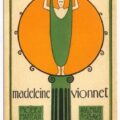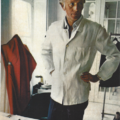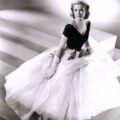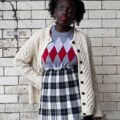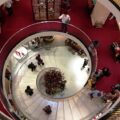Biba – Fashion clothing -The Story of a Brand
September 23, 2014Barbara Hulanicki, the founder of Biba alongside her husband Stephen Fitz-Simon, was born in Poland in 1936 but moved to England via Jerusalem at a young age.She went to Brighton School of Art, studying illustration there, and became successful as an illustrator. She made drawings of the Paris fashion shows in the early Sixties, including Dior, Balenciaga and Balmain.
The Invention of Biba
She liked to draw the models as emaciated, with large eyes, big, doll like heads and a pronounced stoop. Which is more charming than it sounds.
Her illustration work led her to become good friends with a number of fashion editors, connections which stood her in very good stead when she launched her empire.
In 1963, her husband, known as Fitz, told her fashion illustration was dying. He worked in advertising and could see that photography was the imagery of the future. So, she ventured into a little mail order fashion business, calling it Biba after her sister’s nick name.
They started by designing just one simple skirt, which came in four colours. She made a drawing of it and put out an advert.
That design sold a few hundred, but some future designs sold none, while others sold a few dozen. The clothes were paid for in advance before production commenced, and this low risk experience gave the pair the chance to work out what the public was looking for.
The actual cutting and production was taken care of by Royal College of Art fashion students.
Success came only when her good friend, Felicity Green, featured a design in a Mail fashion story, commenting that it was only 25 shillings – extremely cheap! And Biba got 17,000 orders.
It was more than they could fill, so they began to search desperately for a fabric factory to provide the necessary miles of gingham needed.
The Burgess Ledward factory
The factory they found, Burgess Ledward, became a great basis for a relationship as they allowed Barbara to rummage through their archives and were happy to bring back old designs for her, even letting her choose her own colour ways. Eventually, they were to produce fabric designs especially for her too.
At first the company was exclusively mail order – simple, child like designs drawn in her pared down, beautiful style. The aesthetic was of still slouchy models with skinny arms and modish Vidal Sassoon haircuts. The designs themselves recalled the clothes her mother had made for her in her childhood, often featuring a matching headscarf or accessory, as to Hulanicki matching clothes were the epitome of chic.
Everything was designed in such a narrow cut that sometimes it was hard for anyone wearing Biba clothes to move in them. This proved to be a design flaw when Hulanicki moved into designing fur coats: “I wanted the coats to be very narrow, really tight on the arms” she explained, “But when people tried them on [the seams were so strained that] the arms just fell away”.
The price was of the “Pile it High, Sell it Cheap” philosophy. Fitz had calculated that the average weekly wage for a secretary was £9.00. She would spend £3.00 on rent, £3.00 on food, which left her with £3.00 for clothing – therefore, a dress at £2.50 meant that a girl could get a dress every week if she liked, without having to save for it.
Youth quake
Biba had tapped into the disposable income of the youth quake, where teenagers and twenty somethings suddenly had money to spend.
As the mail order company grew, there were naturally some returns of unwanted garments. Hulanicki organized that a sale of these be made in her flat one night. This one night only sale was such a success that the Biba brand began to look for a premises.
The first Biba shop
It was found in 1964 near Kensington High St – the peeling facade of the old chemist’s shop was left intact, and inside, a lush treasure trove. It had no advertising, and no even a sign above the door, and its stock all sold out on the first day.
The shop was designed as a haunt for girls, designed like a Fellini film set where you could hang out, be part of the modish surroundings, and find something new every time you came.
The décor is famous – the windows covered by net curtains to create a gloomy atmosphere, and clothes hung on bentwood hat stands. There was a huge afghan rug in the centre of the room and the wallpaper was a specially designed, swirling Art Nouveau black and gold riot. There was a large font filled with henna, right at the center front of the store which dealers from far and wide came to fill bags with to cut their stashes of hashish. Potted palms dotted the black and white tiled floor. The effect was crowded, fusty and exciting.
Celebrities began to visit – Cilla Black and Cathy McGowan of the popular music TV program “Ready Steady Go” adored the clothes. Yoko Ono bought a dress that she deliberately destroyed in a performance the same night, and both Freddy Mercury and David Bowie were fans.
The brand
The first Biba branded product was a diary, created in 1967. It was black, stamped with the Biba logo in gold, and in the back it listed the addresses of many desirable hang outs for the Biba boys and girls.
By then the Biba mood had darkened, to 30s inspired mutton sleeved dresses, in sludgy colours – plum, brown, and rust. Some featured high, Edwardian necks, or Regency silhouettes.
The Biba woman really was a woman and not a girl – still slender, she had a bust, if a small one, and showed flesh seductively. Her make up was also heavy, with plum lipstick and dark, smoky eyes.
The next Biba shop
A Brighton shop opened and as quickly closed again, a Paris store was mooted but never came to realization.
In 1969 the brand moved to a larger store on Kensington Church Street – it was needed, as the smaller store was regularly mobbed.
And in 1971 the brand moved again, taking over the lease on a huge store, the former Derry and Toms department store that ran over an entire block of Kensington High Street.
Big Biba was massive, a seven story department store that stocked only one brand – you guessed it.
There was a menswear department, shoes, womens wear, wildly successful cosmetics,even an entire hall dedicated to platform boots and a restaurant which doubled as a nightclub in the evening.
There was even a logo shop on the ground floor, in which you could buy into the brand with something as small as a badge for ten pence.
At the height of its popularity, Biba as a brand closed down unexpectedly in 1975, the result of a takeover by majority shareholders. It seems they deliberately ran the company into the ground in order to maximize profit on the property it occupied.
Barbara Hulanicki went on to start a few businesses under her own name, but none were so successful as Biba in terms of global impact and fashion heritage.
Biba logo
Biba Illustrations
Biba catalogue cover
The Daily Mirror Newspaper Feature That Launched Biba
Twiggy in Biba
Biba Fur Jacket
Biba logo
Biba shop girls-1966
Cilla Black and Cathy McGowan Help Biba Move Stores
Biba designs
Biba Makeup
Big Biba’s Cosmetics Counter
Biba Rainbow Room







